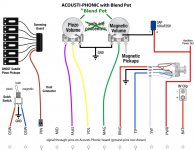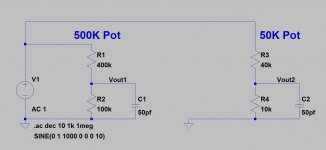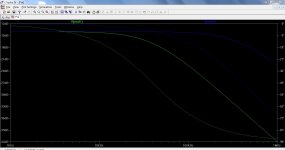Op-Amp Output to High-Impedance Load?
Hi everyone,
I'm working on an on-board guitar preamp for the magnetic pickups to compliment a separate on-board acoustic preamp, namely, the Graph Tech Acousti-Phonic preamp. I've been in contact with their tech people and they tell me the minimum pot value for the Acousti-Phonic is 250K.
Now, in my design I want to have a master volume (magnetic and acoustic) plus a blend between the magnetic and acoustic. Since I can't get either a dual-value dual-gang pot for volume or a dual-value blend pot, and taking into consideration the Acousti-Phonic requirement of a minimum 250K pot value, that means I have to use two 500K pots for the volume and blend in parallel (250K) for the Acousti-Phonic preamp (acoustic-side), but it also means I have to use those same values for my magnetic preamp as well. Unless I'm mistaken, that is!
Attached is the diagram for the Graph Tech preamp. To have both a master volume and blend I thought to wire both pots piggy-back, with the wiper of one feeding the hot of another, at least for the that preamp's "acoustic volume". I've done that before with low-impedance circuits and it's worked well, at least for what I needed.
In my previous on-board circuits I've always used lower-value pots, basically nothing larger than 50K, and they've always worked fine. However, since I have to use 500K pots for this (as I understand it, anyway), which I've never done, are there any special things I have to do except use a 470K input resistor and a 500K post on the feedback loop of the op-amp? Also, can an op-amp output handle feeding a 500K blend pot as shown in the diagram without affecting tone? The magnetic circuit would also include balanced pickup pres, tone and pan, but that's all before the volume and blend and connecting to the Acousti-Phonic.
I hope I've explained this well enough. I've searched for something similar to what I'm trying to do - here and elsewhere - but came up empty. Can someone here, obviously with a heck of a lot more knowledge that I have, help with this by chance?
Thanks in advance!
Hi everyone,
I'm working on an on-board guitar preamp for the magnetic pickups to compliment a separate on-board acoustic preamp, namely, the Graph Tech Acousti-Phonic preamp. I've been in contact with their tech people and they tell me the minimum pot value for the Acousti-Phonic is 250K.
Now, in my design I want to have a master volume (magnetic and acoustic) plus a blend between the magnetic and acoustic. Since I can't get either a dual-value dual-gang pot for volume or a dual-value blend pot, and taking into consideration the Acousti-Phonic requirement of a minimum 250K pot value, that means I have to use two 500K pots for the volume and blend in parallel (250K) for the Acousti-Phonic preamp (acoustic-side), but it also means I have to use those same values for my magnetic preamp as well. Unless I'm mistaken, that is!
Attached is the diagram for the Graph Tech preamp. To have both a master volume and blend I thought to wire both pots piggy-back, with the wiper of one feeding the hot of another, at least for the that preamp's "acoustic volume". I've done that before with low-impedance circuits and it's worked well, at least for what I needed.
In my previous on-board circuits I've always used lower-value pots, basically nothing larger than 50K, and they've always worked fine. However, since I have to use 500K pots for this (as I understand it, anyway), which I've never done, are there any special things I have to do except use a 470K input resistor and a 500K post on the feedback loop of the op-amp? Also, can an op-amp output handle feeding a 500K blend pot as shown in the diagram without affecting tone? The magnetic circuit would also include balanced pickup pres, tone and pan, but that's all before the volume and blend and connecting to the Acousti-Phonic.
I hope I've explained this well enough. I've searched for something similar to what I'm trying to do - here and elsewhere - but came up empty. Can someone here, obviously with a heck of a lot more knowledge that I have, help with this by chance?
Thanks in advance!
Attachments
I don't fully understand what you are trying to do with the opamp tbh, but, the opamp can be arranged to have as high an input impedance as you want (pickup input ?) and it can drive loads down to 1k or lower. So once buffered by the opamp you are not restricted to high value pots.
Maybe I'm not understanding what you are trying to do 🙂 You would have to draw it with the opamps as a circuit diagram and then it would make more sense (to me at any rate 😀)
Maybe I'm not understanding what you are trying to do 🙂 You would have to draw it with the opamps as a circuit diagram and then it would make more sense (to me at any rate 😀)
I'm referring to output impedance, not input. The op-amp's output would have to be connected to a 500K load (pot) to connect to the Acousti-Phonic preamp as shown in the diagram. Where it shows "Magnetic Pickups" would instead be the output of the op-amp. I need to know if anything special needs to be done with the circuit so the pot operates as it should without any loss of tone. I can draw a block diagram when I get home if need be?
Thanks!
Thanks!
OK, well the opamp will have no issues driving 500k and will not alter the tone at all. What a 500k pot might cause is alteration of the frequency response (but that's nothing to do with the opmp driving it) because of the filter effect caused by the pots high and variable value (as its rotated) and the input capacitance of the circuitry connected to the wiper.
But to answer the question on the opamp... it will drive 500k perfectly.
But to answer the question on the opamp... it will drive 500k perfectly.
"Alteration of the frequency response". Sounds like that would alter the tone then. Are we talking about high-frequency attenuation?
"Alteration of the frequency response". Sounds like that would alter the tone then. Are we talking about high-frequency attenuation?
Yes... but the opamp plays no part. The pot on its own does that with having such a high value.
Look at this circuit. There are two versions, one with a 500k pot and one with a 50k. The voltage source represents whatever is feeding the pot (opamp, another amp, whatever). The capacitor is fixed and represents the input capacitance of the stage the pot wiper is feeding. The pot is represented as two resistors, for example 400k and 100k to simulate it having been rotated a little.
Look at the two solid lines for Vout1 and Vout2. Do you see how the high frequencies are attenuated with the higher value pot.
Attachments
Understood. I believe that can be mitigated somewhat with a treble bleed cap on the pot from hot to wiper, if that's even necessary. After all, this is for a guitar so anything above 15-20K can be disregarded (can't hear anything much higher anyway) and the slope shows only about a 3dB drop at 20K. I'll play around with that a little once I get all the parts together.
I really appreciate your help with this!
I really appreciate your help with this!
A bleed cap as you call it would tend to be a bit non linear because the resistances change as the pot is turned. Also, I made a guess at the capacitance of the stage the pot might feed, so it could be higher (maybe a lot higher) or a bit lower in practice.
Once you have an opamp feeding the pot (which is acting as a buffer) then you can go much lower in pot value. A 10k pot would show essentially zero alteration of response due to the capacitance of the stage following it.
Obviously, try what you have in mind first and see how it all works out.
Once you have an opamp feeding the pot (which is acting as a buffer) then you can go much lower in pot value. A 10k pot would show essentially zero alteration of response due to the capacitance of the stage following it.
Obviously, try what you have in mind first and see how it all works out.
Yes, I'll play around with it a little, if it's even needed of course. Generally, in a guitar wired passively from the pickups, turning a 500K pot down does reduce some of the highs, but many people use a treble bleed circuit consisting of a cap, sometime wired in series or parallel with a resistor, and sometime wired with a resistor in series and parallel. There are many thoughts as to what works best with those mods and what the best values are, but I'll try some things and figure out what sounds best to me.
I appreciate with something like this, that "what works best" or what sounds right" is what you are probably after. In such cases there is no right and wrong... but it can help to know why things work as they do and what the effect of component changes may be.
Good luck with it all 🙂
Good luck with it all 🙂
I completely agree with mooly that the 500k value was intended for passive pickups that have high output impedance. Since you have an opamp buffer you can go with a much lower value pot like a 10k.
No, I can't. Please reread my original post.
My mistake I misinterpreted your original post and the responses.
The opamp will drive the smaller load of 250k easier than the 50k you were using before (which 50k is fine because opamps have very low output impedance). So you will actually get less of a high frequency roll off actually with the 250k.
As far as the increased value of 250k loading the next stage it depends on what it's going into. Things like input capacitance, input impedance, and cable length are factors but if you are plugging into a guitar amp than the 250k value is very common amongst guitar volume control values and shouldn't be an issue.
I don't think a treble bleed cap will help that much IMHO. I have only seen them used because of people loading passive pickups with large value pots like 1Meg.
Maybe I am still misunderstanding the question?
No, I can't. Please reread my original post.
Sorry but your OP is not clear.
Why do you say you can´t use a pot lower than 250K or 500K?
And please draw the full diagram of what you are building, so far you have only shown the Acoustiphonic wiring diagram but you are not showing the pickups and even less the extra preamps you are adding.
We have to imagine the rest.
Thanks.
Last edited:
- Status
- Not open for further replies.
- Home
- Live Sound
- Instruments and Amps
- Op-Amp Output to High-Impedance Load?


